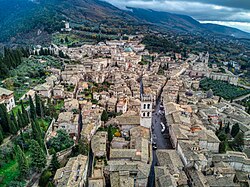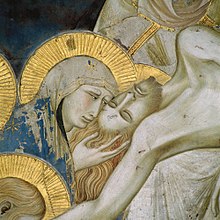Assisi
Assisi
Ascesi | |
|---|---|
| Comune di Assisi | |
 Assisi | |
UTC+2 (CEST) | |
| Postal code | 06081 |
| Dialing code | 075 |
| Patron saint | St. Rufinus of Assisi |
| Saint day | 12 August |
| Website | www |
| Official name | Assisi, the Basilica of San Francesco and Other Franciscan Sites |
| Includes | San Damiano, Eremo delle Carceri, Santuario di Rivotorto, Basilica of Santa Maria degli Angeli and Palazzo del Capitano del Perdono |
| Criteria | Cultural: i, ii, iii, iv, vi |
| Reference | 990 |
| Inscription | 2000 (24th Session) |
| Area | 14,563.25 ha |
| Buffer zone | 4,086.7 ha |
Assisi (
It is generally regarded as the birthplace of the Latin poet
History
The earliest attested people of Assisi were the
The Augustan age poet Propertius is considered to have been born in what is now the city of Assisi.
In 238 AD Assisi was converted to Christianity by bishop Rufino, who was martyred at Costano. According to tradition, his remains rest in the Cathedral Church of San Rufino in Assisi.
The Ostrogoths of king Totila destroyed most of the town in 545. Assisi then came under the rule of the Lombards as part of the Lombard and then Frankish Duchy of Spoleto.
The thriving

The city, which had remained within the confines of the Roman walls, began to expand outside these walls in the 13th century. In this period the city was under papal jurisdiction. The Rocca Maggiore, the imperial fortress on top of the hill above the city, which had been plundered by the people in 1189, was rebuilt in 1367 on orders of the papal legate, cardinal Gil de Albornoz.
In the beginning, Assisi fell under the rule of Perugia and later under several despots, such as the soldier of fortune Biordo Michelotti, Gian Galeazzo Visconti and his successor Francesco I Sforza, dukes of Milan, Jacopo Piccinino and Federico II da Montefeltro, lord of Urbino. The city went into a deep decline through the plague of the Black Death in 1348.
The city came again under papal jurisdiction under the rule of Pope Pius II (1458–1464).
In 1569 construction was started of the
Now the site of many a pilgrimage, Assisi is linked in legend with its native son, St. Francis. The gentle saint founded the Franciscan order and shares honours with St. Catherine of Siena as the patron saint of Italy. He is remembered by many, even non-Christians, as a lover of nature (his preaching to an audience of birds is one of the legends of his life).

During
Assisi was hit by two devastating earthquakes that shook Umbria in September 1997. But the recovery and restoration have been remarkable, although much remains to be done. Massive damage was caused to many historical sites, but the major attraction, the Basilica di San Francesco, reopened less than 2 years later.
Main sights
UNESCO collectively designated the Franciscan structures of Assisi as a World Heritage Site in 2000.
Churches
- Giotto; the upper church houses frescoes of scenes in the life of St. Francis previously ascribed to Giotto, but now thought to be by artists of the circle of Pietro Cavallinifrom Rome. The Basilica was badly damaged by a 5.5 earthquake on 26 September 1997, during which part of the vault collapsed, killing four people inside the church and carrying with it a fresco by Cimabue. The edifice was closed for two years for restoration.
- Santa Maria Maggiore (St. Mary the Greater): earliest extant church in Assisi.
- Roman era.
- namesake saint.
- Porziuncola.
- Chiesa Nuova: church built over the presumed parental home of St. Francis
- Santo Stefano: one of the oldest churches of Assisi.
- Eremo delle Carceri: a small monastery with a church at a canyon above the town, where St. Francis retreated and preached to birds
- rose windows; the Gothic chapel of the Holy Sacrament houses a triptych by Matteo di Gualdo.
- Church of San Damiano is where Saint Clare and the Poor Clares lived and is the location of Saint Francis' conversion.
Other landmarks



The town is dominated by two medieval
Other sights include:
- the Roman amphitheater, built in the early 1st century AD. Its elliptical plan is identifiable from the medieval houses built around it, and from an arch of travertine cunei. The arena now houses a garden.[11]
- the Piazza del Comune ("Communal Square"), with the Palazzo del Capitano del Popolo (mid-13th century, featuring a series of merlons added in 1927), the adjoining Torre del Popolo ("People's Tower", 1305) the Palazzo dei Priori ("Palace of the Priors", 1275–1493). The fountains with three lions on the southern side date from the 16th century.
- The Temple of Minerva, also facing the Piazza del Comune
- The abbey of St. Benedict, founded in the 10th century on the Monte Subasio. Remains include the crypt (late 11th century), the apse and the external walls.

Art
- See also Art in Assisi
Assisi has had a rich tradition of art through the centuries and is now home to a number of well-known artistic works.[12]
Artists
Culture

The Calendimaggio Festival takes place on the first four days of May ending on a Saturday. The festival is a re-enactment of medieval and Renaissance life in the form of a challenge between the upper faction (parte de sopra) with a blue flag and the lower faction of the town (parte de sotto) with a red flag. It includes processions, theatrical presentations, choirs, crossbow, flag-waving and dancing contests.
Assisi Embroidery is a form of counted-thread embroidery which has been practised in Assisi since the 13th century.
Today many groups gather in Assisi for a variety of cultural and religious activities. One such group[ host musical performances and other cultural events.
Saints
Assisi was the home of several saints, including:
- Agnes of Assisi
- Clare of Assisi
- Francis of Assisi
- Gabriel of Our Lady of Sorrows
- Rufinus of Assisi
- Vitalis of Assisi
- Sylvester of Assisi
Transport
International relations
Twin towns – sister cities
Assisi is
 Bethlehem, Palestine
Bethlehem, Palestine San Francisco, United States
San Francisco, United States Santiago de Compostela, Spain
Santiago de Compostela, Spain Wadowice, Poland
Wadowice, Poland
Others
The two
Sources
- ^ "Superficie di Comuni Province e Regioni italiane al 9 ottobre 2011". Italian National Institute of Statistics. Retrieved 16 March 2019.
- ^ "Resident population". demo. Istituto Nazionale di Statistica. Retrieved 10 November 2022.
- ^ "Assisi". Lexico UK English Dictionary. Oxford University Press. Archived from the original on 22 March 2020.
- ^ "Assisi". The American Heritage Dictionary of the English Language (5th ed.). HarperCollins. Retrieved 31 May 2019.
- ^ "Assisi". Collins English Dictionary. HarperCollins. Retrieved 31 May 2019.
- ^ "Assisi". Merriam-Webster.com Dictionary. Retrieved 31 May 2019.
- ^ Bostock, John (2018). Pliny the Elder, The Natural History. Perseus Digital Library.
- ^ "Assisi in World War II: Convents Shelter the Jewish Refugees". Annesitaly. 3 February 2021.
- ^ "How Catholic leaders in Assisi, and even a German officer, saved Jews in WWII". Aleteia – Catholic Spirituality, Lifestyle, World News, and Culture. 2 July 2020.
- ^ read, Deborah Castellano Lubov·Trending News··4 min (27 January 2022). "Historic Significance of Assisi in Protecting Jewish Refugees". Exaudi.
{{cite web}}: CS1 maint: numeric names: authors list (link) - ^ Harris, W.; DARMC, R. Talbert; S. Gillies, J. Åhlfeldt; J. Becker, T. Elliott (22 September 2019). "Places: 413037 (Asisium)". Pleiades. Retrieved 8 November 2014.
- ^ "Web Gallery of Art – Art of Simone". wga.hu.
- ^ "Pietro Lorenzetti :: Biography ► Virtual Uffizi". Virtual Uffizi Gallery.
- ^ "Umbria Art". Archived from the original on 30 January 2009. Retrieved 23 February 2009.
- ^ "Assisi Performing Arts - Summer Music Festival in Assisi, Italy". assisiperformingarts. Retrieved 14 July 2023.
- ^ "Documento Unico di Programmazione 2016-2021 – DUP" (PDF). comune.assisi.pg.it (in Italian). Assisi. October 2016. p. 63,78. Retrieved 13 December 2019.
External links
- Official website

 Assisi travel guide from Wikivoyage
Assisi travel guide from Wikivoyage- Ashby, Thomas (1911). . In Chisholm, Hugh (ed.). Encyclopædia Britannica. Vol. 2 (11th ed.). Cambridge University Press. p. 762.



